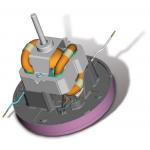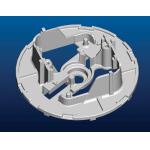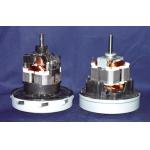Cleaning Up with Rapid Injection Molding
How vacuum cleaner motor producer Ametek beat the competition using Protomold's rapid injection molding service.
Latest News
June 1, 2005
By Jerry Nelson
As a leading global manufacturer of electronic instruments and air-moving electric motors, Paoli, PA-based Ametek excels in manufacturing specialized motors for the floor-care industry. Recently, the company launched a new line of household vacuum-cleaner motors named Advantek. These motors are unique not only because of their distinctive design and high performance, but also because they represent the culmination of an innovative product design and development methodology used by Ametek engineers to bring these motors to market.
The primary objectives in the design of the Advantek motors were to offer vacuum cleaner OEMs maximum performance by increasing airflow efficiency and improving motor life, while simultaneously reducing noise. Even though these design goals are intuitively at odds with each other, they are actually key system performance criteria and are frequently requested by vacuum cleaner manufacturers. For Ametek design engineers, achieving such goals meant searching beyond traditional solutions to radically alter two core elements of the electric motor: the carbon brush system, which helps regulate current, and the air-handling diffuser, which provides both the internal cooling air circulation and the vacuum’s suction.
|
|
| This Pro/Engineer model of a prototype vacuum cleaner motor shows its inverted armature. Protomold supplied the rapid injection molded parts for the working version. Click on image to enlarge. |
In conventional vacuum motor models, the carbon brush system is generally mounted on top of the motor’s rotating armature. Temperature regulation in such a setup is adequate, but not optimum. In an effort to get better airflow efficiency, Ametek engineers sketched out a design, using Pro/ Engineer from PTC (Needham, MA), with the armature support and carbon brush system flipped over so they rested upside down in the motor.
The design engineers anticipated that this would route the coolest air directly to these critical motor parts. Because the carbon brush system in this new design would be located at the bottom of the motor, directly beside the diffuser, the motor would receive the cooling air directly from the diffuser first, before the air flowed over the warm motor. The engineers expected this to reduce parasitic high temperatures and improve brush and motor life; a critical improvement vital to enhance motor performance and allow greater airflow efficiencies.
With projected airflow improvements sketched out, Ametek designers moved to improve the design further by trying to remedy the second concern of their customers: disruptive motor noise. To address this challenge, they tackled a redesign of the air diffuser, which is responsible for pumping air through the vacuum cleaner system. By reconfiguring the fan-blade arrangement and port placement within the blades of the air diffuser, Ametek anticipated a significant reduction in overall motor noise.
With all of this advanced design work in place, Ametek needed to determine the best way to present the new design’s predicted capabilities to key customers in the floor-care industry. To accurately demonstrate the new concept and win the business, it was crucial that they get in front of the customer before the competition, with a real, functional model.
A Different Approach for a New Design
Ametek engineers knew that using a traditional, hand-crafted model to illustrate the motor’s capabilities to potential customers wouldn’t do justice to Advantek’s innovative design. On the other hand, they also knew that conventional prototyping methods couldn’t provide the quality they needed. So, they explored new options for creating a “real” part to win customer approval.
After a member of the design team recalled hearing about a new method to quickly develop plastic injection-molded parts, the Ametek design team logged onto the website of Protomold, a provider of rapid injection-molded parts and prototypes. An increasingly popular technology, rapid injection molding uses MCAD software and high-speed CNC machining to produce injection-molded parts from 3D CAD models quickly.
|
|
| This motor output end bracket was one of numerous parts supplied to Ametek by Protomold for its new vacuum-cleaner motor. It helped win a contract by satisfying a customer request for increased airflow efficiency, improved motor life, and a reduction in noise. Click on image to enlarge. |
Impressed with what they saw on the website, Ametek designers submitted their 3D CAD design online to explore the feasibility of creating their prototype using the process. The team then received an interactive ProtoQuote from Protomold of Maple Plain, MN. ProtoQuote is a Web-based quotation that offers suggestions for potential design improvements using different materials, compares lead-time options, and lists final price points based on quantity.
“With ProtoQuote, we were able to analyze our part models, specifically looking at key design elements that might affect lead time, right from the start,” said Jim Shawcross, vice president of engineering in Ametek’s global floor care motors division. “Making design changes online versus trying to describe alterations over the phone, which could mean possible miscommunication, proved a huge advantage for us in getting a functional model in front of our customers within an unprecedented week’s time frame.”
The Ametek design team received functional pilot parts in five days to use in customer demonstrations for design approval. By avoiding their industry’s customary practice of supplying hand-built models, the engineers won the new business and helped streamline the demanding product design and development process that came next.
Unclogging Previous Processes for Superior Performance
After using a functional, rapid injection-molded part to help win the new business, Ametek designers moved forward on a strict product design and development process schedule of 12 months to meet product rollout deadlines for household vacuum cleaner manufacturers. Within this time frame the design team was allotted seven months to finalize the motor design, complete design and performance testing, and ramp up their motor manufacturing facility. Not surprisingly, Ametek designers were in serious need of a prototype process that could handle a short turnaround request, without sacrificing quality.
|
|
| This image shows a conventional vacuum-cleaner motor (left) and the new Advantek (right). Rapid prototyping helped Ametek win a contract to build motors where the armature support and carbon brush system hang upside down, increasing cooling and helping reduce noise. Click on image to enlarge. |
With pressures for a quick turnaround at all stages of the product design and development process, Ametek designers needed an alternative to typical prototype-creation methods. For example, in Ametek’s experience, most rapid prototyping methods, although speedy, could deliver only one part per run and involved materials that tended to melt or deform during rigorous performance tests. In addition, functional testing was often put on hold until a production tool could be developed, a process typically requiring a large financial investment and up to 16 weeks to develop.
Instead of delaying performance testing until a production tool could be created, Ametek again used Protomold’s rapid injection-molding service to create 100 production-quality parts, enabling key tests to be conducted by its customer and its engineering and manufacturing departments within just one week.
Protomold provided Ametek with real injection-molded parts constructed in Rynite, a plastic material strong enough to survive the heat and pressure generated by electrical motor performance tests. During initial tests, Ametek engineers were able to obtain enough preliminary airstream and thermal temperature measurement data to confirm the Advantek motor line’s performance and begin tool development for high-volume production.
Rapid injection molding helped Ametek break through traditional product development barriers by helping its engineers get a functional part model in front of the customer first with by providing injection-molded parts quickly, so performance testing could be completed far earlier in the process.
“If we’d had to wait on the production tool to uncover a fundamental design problem, we would’ve been in a tough spot,” Shawcross said. “Being able to actually use these prototype parts to catch potential adjustments before going into production, especially with the tighter timelines, really gave us a head start and helped keep our customers happy.”
Jerry Nelson is a wannabe jazz drummer who writes to support his musical habit. To comment on this article, you can send an e-mail c/o DE’s Editors.
Subscribe to our FREE magazine, FREE email newsletters or both!
Latest News
About the Author
DE’s editors contribute news and new product announcements to Digital Engineering.
Press releases may be sent to them via [email protected].









